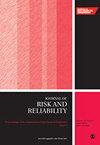基于马尔可夫链的遗传算法求解可修热备用系统的冗余分配问题
IF 1.8
4区 工程技术
Q3 ENGINEERING, INDUSTRIAL
Proceedings of the Institution of Mechanical Engineers Part O-Journal of Risk and Reliability
Pub Date : 2023-03-30
DOI:10.1177/1748006x231164848
引用次数: 1
摘要
基于冗余分配问题(RAP)的系统设计已经进行了许多研究。然而,由于复杂的数学模型,研究人员在一定程度上忽略了可修复的热备部件(即使在空闲状态下也会发生故障)。这些系统的一个关键方面是考虑切换到备用组件或子系统时的故障概率。本研究试图突出这些不完善的交换和交换选择策略在冗余分配设计。为此,本文提出了一种基于遗传算法(GA)和马尔可夫链的求解方法,建立了具有热备可修部件的单目标和双目标RAP模型。由于模型的目标函数使系统的平均无故障时间(MTTF)和成本最小化,我们讨论了不完美开关如何影响所提出的RAPs的总系统成本和平均无故障时间。最后,由于模型的复杂性,我们采用遗传算法和非支配排序遗传算法(NSGA-II)对所提出的模型进行求解。这些模型的求解清楚地表明,选择合适的切换策略对系统的成本和可靠性至关重要。本文章由计算机程序翻译,如有差异,请以英文原文为准。
A Markov chain-based genetic algorithm for solving a redundancy allocation problem for a system with repairable warm standby components
Many studies have been conducted on designing systems based on the redundancy allocation problem (RAP). However, considering repairable warm-standby components (which are subject to failure even in an idle state) is somewhat neglected by researchers due to the complex mathematical models. One of the crucial aspects of these systems is considering the probability of failure when switching to a standby component or subsystem. This study tries to highlight these imperfect switching and switch selection strategies in the redundancy allocation designs. In this regard, this article is dedicated to developing two RAP models (a single objective and a bi-objective) with warm standby repairable components by proposing a solving approach based on the genetic algorithm (GA) and Markov chains. Since the model’s objective functions minimize the system’s mean time to failure (MTTF) and cost, we discussed how imperfect switches affect the total system’s cost and mean time to failure for the proposed RAPs. Finally, we adopted a GA and a non-dominated sorting genetic algorithm (NSGA-II) to solve the proposed models due to the models’ complexity. Solving these models clearly indicates the critical role of selecting an appropriate switching strategy on the system’s costs and reliability.
求助全文
通过发布文献求助,成功后即可免费获取论文全文。
去求助
来源期刊

Proceedings of the Institution of Mechanical Engineers Part O-Journal of Risk and Reliability
ENGINEERING, MULTIDISCIPLINARY-ENGINEERING, INDUSTRIAL
CiteScore
4.50
自引率
19.00%
发文量
81
审稿时长
6-12 weeks
期刊介绍:
The Journal of Risk and Reliability is for researchers and practitioners who are involved in the field of risk analysis and reliability engineering. The remit of the Journal covers concepts, theories, principles, approaches, methods and models for the proper understanding, assessment, characterisation and management of the risk and reliability of engineering systems. The journal welcomes papers which are based on mathematical and probabilistic analysis, simulation and/or optimisation, as well as works highlighting conceptual and managerial issues. Papers that provide perspectives on current practices and methods, and how to improve these, are also welcome
 求助内容:
求助内容: 应助结果提醒方式:
应助结果提醒方式:


